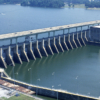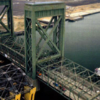Overview
The Hiwassee dam and power plant on the Hiwassee River near Murphy, North Carolina, was built by TVA between 1936 to 1940 as a flood control and electrical generating facility. Hiwassee Dam is the tallest overspill dam in the world at 307 feet tall. The dam is 1,285 feet wide, and is composed of a 260-ft long central spillway section, and two non-overflow sections on the left and right side of the spillway, measuring 597 and 428 ft, respectively. There is a roadway over the top of the dam with bridge spans at the spillway bays. The main spillway consists of seven radial gated bays. The initial power installation consisted of a single conventional Francis turbine driving a generator with a rating of 57,600 kW, placed in service in May 1940. Space was provided in the powerhouse for later installation of a second unit. In 1955, the second generating unit was added to the dam, along with the world’s largest electric motor and reversible pump-turbine. This enables water from the dam to be used to generate electricity during peak hours. During off-hours, water is then pumped 205-feet back into the Hiwassee reservoir for reuse.
Dam Expansion
Concrete growth at Hiwassee Dam, caused by an alkali-aggregate reaction (AAR) aggravated by high summer temperatures, has caused expansion of the dam. This expansion partially closed the spillway, jamming the gates and causing significant structural cracking in the abutments. The instrumentation from original construction at Hiwassee continues to function, this includes uplift cells, plumb-lines, and gallery drainage weirs. In recent years, crack gages, extensometers, growth meters, inclinometers, stressmeters, and tiltmeters have been installed to monitor cracking and other problems that have developed due to AAR. Alignment, settlement, and EDM surveys have also been initiated to monitor the overall closure of the spillway and movement of the dam.
Implemented Instruments
Over the years various types of remedial action have been undertaken at the dam, including the cutting of slots to control long-term damage, the most recent of which were completed in 1994, and pairs of posttensioned anchors installed on the spillway piers in 2004. Canary Systems Project Profile – Dam Concrete Growth
At present there are approximately 325 instruments connected to (6) automated systems at the Dam. These include uplift pressure cells (40), piezometers (6), growthmeters (12), tiltmeters (36), barometers (2), convergence meters (12), crackmeters (42), extensometers (6 in total with 17 instruments), jointmeters (64), over-core stress cells (80) and trunnion pin displacement gages (14). In addition there are approximately 320 temperature measurements at the instrument locations (using thermistors embedded in the instruments), and (6) optical pendulums also being recorded automatically.
What We Did
We have been involved with numerous phases of improvement/expansion of the monitoring systems at Hiwassee Dam, this has included the following types of work: • Supply of MultiLoggerDB to manage all the systems, automate data collection and manage the data. The software is installed on the TVA LAN which allows data access to key TVA personnel.
Use of MultiLoggerDB allows for a completely automated data collection and data access system.
- Creation of the initial MultiLoggerDB database for the project. This involved extraction of historical data, both electronic and manual (some extending back to 1992), extraction of formulas from numerous Excel worksheets, development of the project interface, resolution of numerous calculation issues, and development of over 300 calculations to support the various types of instrumentation and the various data reduction methods. The database system was deployed in January of 2004 and has been in continuous operation since.
- Supply of the electronic pendulums and ADAS to automate the measurements. This required retro-fitting existing systems to facilitate automating measurements over the RS-485 pendulum interface.
- Retrofit of all datalogging systems installed at the Dam with the Canary Systems VWDSP Vibrating Wire Interface, to provide improved reading reliability for the vibrating wire instrumentation.
- Supply of datalogging systems and components to provide for expanded monitoring programs.


